Daewonsagyegok Valley (대원사계곡)
0m 46018 2021-02-24
Samjang-myeon, Sancheong-gun, Gyeongsangnam-do
+82-55-970-7201
Daewonsagyegok Valley is a place where one can be appreciate nature's musical harmony of stream water, wind brushing against the leaves, and the chirping of birds. The nearly 12-kilometer-long Daewonsagyegok Valley's stream water originates from the highest peak of Jirisan Mountain called Cheonwangbong Peak, and flows through Jungbong and Habong Peaks, as well as Ssukbatjae Pass, Saejae Pass, Wangdeungjae Pass, Bammeorijae Pass, and Ungseokbong Peak. Before reaching the valley, the water joins the currents from Sinbatgol, Jogaegol, and Bambatgol Valleys. The volume of water increases as it passes Saejae and Oegok Village and reaches Yupyeong-ri where Daewonsa Temple is located. The incessant sound of running water fills the silence of the forest as if Buddhist nuns were chanting blessings.
Sancheong Daewonsa Temple (대원사(산청))
337.1586290392657m 18168 2021-08-13
453, Pyeongchonyupyeong-ro, Sancheong-gun, Gyeongsangnam-do
+82-55-972-8068
Located at the eastern foot of Jirisan Mountain, Daewonsa Temple was first built in 548 during the Silla dynasty, but it remained closed for over thousand years until it was renovated and made bigger with the name Daewon. Unfortunately, the entire premises were lost to a big fire during the night of January 12, 1914, and all the halls and pavilions, including Yosachae, totaling 184 rooms in 12 buildings, were rebuilt in 1917. However, they were damaged once again during the Korean War and were abandoned until the war ended where the temple was rejuvenated and made even bigger. Located nearby are Geoyeonjeong and Gunjajeong Halls that are believed to have been the studying venue of scholars.
* Daewonsa Valley
The two-kilometer-long valley that stretches from the parking lot at the entrance to Daewon Temple to the temple itself is surrounded by high hills and curious-looking rocks. The clean water that oozes out through craters between the rocks generates unusual scenery. Associated with Yongso Pond is the legend that a dragon lived in it for hundreds of years before it finally flew away. Somakgol Valley is known to be the place where the last king of Garak Kingdom came to feed his cows and horses.
Suseonsa Temple (수선사)
7.2 Km 0 2024-02-23
1117 Nae-ri, Sancheong-eup, Sancheong-gun, Gyeongsangnam-do
Suseonsa Temple is a temple situated on Ungseokbong Peak in Jirisan Mountain. Renowned for its picturesque hydrangea and lotus, it has become a favored destination for many visitors. The temple offers a temple stay program, allowing participants to restore both body and mind. Nearby, the café run by Suseonsa Temple provides a pleasant retreat, adding to the enjoyment of visitors' experiences.
Jirisan National Park (Sancheong) (지리산국립공원(산청))
7.8 Km 74998 2024-02-27
320-2 Jirisan-daero, Sicheon-myeon, Sancheong-gun, Gyeongsangnam-do
+82-55-970-1000
Jirisan National Park is the first national park established in South Korea, featuring peaks like Cheonwangbong Peak (1,915m), Banyabong Peak, and Nogodan Peak, which rank as the next highest after Halla Mountain. It's a popular destination for mountain enthusiasts, offering beautiful natural landscapes such as Naewonsagyegok Valley. The park also provides convenient facilities like Jirisan Recreational Forest, Naewonsa Temple, mountain lodges, campgrounds, and pensions.
Jirisan Chilseongyegok Valley (칠선계곡(지리산))
7.9 Km 34739 2022-07-29
Chuseong-ri, Hamnyang-gun, Gyeongsangnam-do
+82-55-970-1000
Chilseongyegok Valley is the most beautiful valley in Jirisan Mountain, and is one of the top three valleys in the nation, along with Cheonbuldonggyegok Valley in Seoraksan Mountain and Tamnagyegok Valley in Hallasan Mountain. The 16-kilometer valley stretching from Uitan of Macheon-myeon to Cheonwangbong Peak is characterized by very tough topography but beautiful scenery and is the only remaining primeval forest of Jirisan Mountain. It is also dotted with seven waterfalls and 33 ponds. The hike becomes more difficult as the trail enters the valley. Because the valley has taken many lives, some people call it "The Valley of Death." For that reason, visitors must apply in advance and hike with a guide. The trail in Chilseon Valley is a 9.4-kilometer course from Chuseong Village in Macheon-myeon to Cheonwangbong Peak, which does not follow the natural valley, due to the valley's steep and dangerous features. Starting from Chuseong Village, the trail passes Yongso Pond, Jujiteo Site, Chuseongmang Rock, Seonnyeotang Pond, Ongnyeotang Pond, Biseondam, Chilseonpokpo Falls, Daeryukpokpo Falls, Samcheungpokpo Falls and Mapokpo Falls, all before reaching Cheonwangbong Peak.
Baegundonggyegok Valley, Sancheong (백운동계곡(산청))
9.3 Km 7508 2019-12-19
Baegun-ro 51beon-gil, Danseong-myeon, Sancheong-gun, Gyeongsangnam-do
+82-55-970-6421~3
If you go 5 km up along the valley at Baegam-ri, under the thick woods, you will find a 180 square meter long stone named ‘Jeomjeong Rock’ and a small waterfall. This valley is Baegundonggyegok Valley. For almost 6 km, the water of the valley flows over only rocks, with over twenty large and small falls and lakes. Large stones in the valley are gorgeous because the stones are washed with sunbeams and the strong current of water. The most famous falls are Baeunpokpo Waterfall and Odampokpo Waterfall. Strong current of water flows in Deungcheondae, where the letters ‘Yeongnamjeilcheonsok’ are carved. Baegundonggyegok Valley is a clean area due to maintenance of the clean natural environment. Many tourists visit here because the valley is decorated with azaleas in the spring and it is cool in the summer.
Donguibogam Village (산청 동의보감촌)
9.4 Km 12225 2018-10-18
45-6, Donguibogam-ro 555beon-gil, Geumseo-myeon, Sancheong-gun, Gyeongsangnam-do
+82-55-970-7216
The Donguibogam Village (Sancheong Oriental Medicine Theme Park) was established in 2005 and is the first herbal medicine-themed park in Korea. This theme park was designed based on the five elements of the universe according to traditional Korean medicine. The village combines eco-friendliness and traditional Korean medicine content, using eco-friendly materials for various props and designs.
Sancheong Medicinal Herb Festival (산청한방약초축제)
9.6 Km 26047 2023-09-14
Maechon-ri, Sancheong-gun, Gyeongsangnam-do
+82-55-970-6601~5
The Sancheong Medicinal Herb Festival is held in September at Sancheong, home of Jirisan Mountain where over 1,000 medicinal herbs can be found. Jirisan Mountain is also famous as a place where notable physicians in the past researched and practiced medicine. The festival includes various exhibitions and events to learn about and experience Korea's medicinal herbs firsthand. Visitors can also enjoy traditional games and wear clothes from the Joseon dynasty.
Sancheong Museum of Herbal Medicine (산청 한의학박물관)
9.6 Km 18969 2020-09-05
45-6, Donguibogam-ro 555beon-gil, Sancheong-gun, Gyeongsangnam-do
+82-55-970-7216
Sancheong Museum of Herbal Medicine is the first herbal medicine museum in Korea. The museum is located at the foot of Wangsan Mountain, where the two prominent doctors of the mid-Joseon dynasty (1394-1910), Ryu Ui-tae and his apprentice Heo Jun practiced Korean herbal medicine. As a medicine-themed tourist park, it offers visitors a variety of health-related experiences. It is growing into a popular tourist attraction in the area with a wide range of recreational facilities including the Museum of Herbal Medicine, a medicinal herb garden, medicinal herb forest park, accommodations, herbal medicine facilities, shops, and more.
Tomb of King Guhyeong, Sancheong (산청 전 구형왕릉)
10.4 Km 18145 2020-06-30
Guhyeongwangneung-ro, Sancheong-gun, Gyeongsangnam-do
+82-55-970-6411
This stone grave is known to be the tomb of King Guhyeong, the 10th King of the Gaya Kingdom. He is also known as King
Guhae or King Yang, and is the grandfather of Kim Yoo Shin. Since becoming
the King of Gaya in 521 AD, he reigned for 11 years until he handed over his
country to King Beopheung of the Silla Kingdom in 532 AD.
There are two
different scholarly opinions about this tomb. One is that it should be classified as a stone pagoda and the
other, a royal tomb. The reason why this was regarded as a pagoda is
that there are similarly shaped stone pagodas in the Andong and Uiseong regions.
The basis for it being called Wangreung, or royal tomb, is that there is a record in Dongguk Yeoji Seongram (an
ancient history book published during the rule of King Seongjong in the Joseon dynasty) and
in Saneum-hyeon Sancheonjo (a record of events in the region) of it being a
tomb. The
notes state that "there is a structure with steps on
the four faces, in the form of nine dragons piled up of stones at a distance
of about 16 km (40 ri in traditional Korean scale) from the village, so
people believe it must be a royal tomb".
The record describing the name of the king buried
in this tomb can be extracted from a record of travels called Wangsan Shimreunggi
written by Hong Ui Young, a Joseon dynasty scholar. In addition, there’s also
an entry in Wangsansagi, a book on the history of Wangsansa Temple (a
temple located west of the tomb) that the person buried in the tomb is King Guhyeong.
Unlike ordinary
graves, the tomb is built at the middle part of the hill's slope. The tomb
has a unique appearance made up of steps and layers, with the highest point
being 7.15 meters high. There are seven layers at the front and no steps at
the back due to it being built on an inclined surface. The overall shape of
this tomb is different from the pyramids built on level ground. The top of the tomb is oval in
shape. At the center, there is a stone tablet with the words "Royal Tomb of King Yang of the
Garak Nation". In front of the tomb, there are several stone pieces that
have been added to the original tomb.
During the 17th Year of King
Jeongjo of the Joseon dynasty (1793), a wooden box that was passed down from generation
to generation in Wangsansa Temple was discovered. The box contained portraits
of King Guhyeong and his queen, their clothes, an archery bow, and other objects. To
preserve these, a royal building called Deogyangjeon Hall was
constructed. To this date, a memorial service is held here in spring and
autumn of every year.
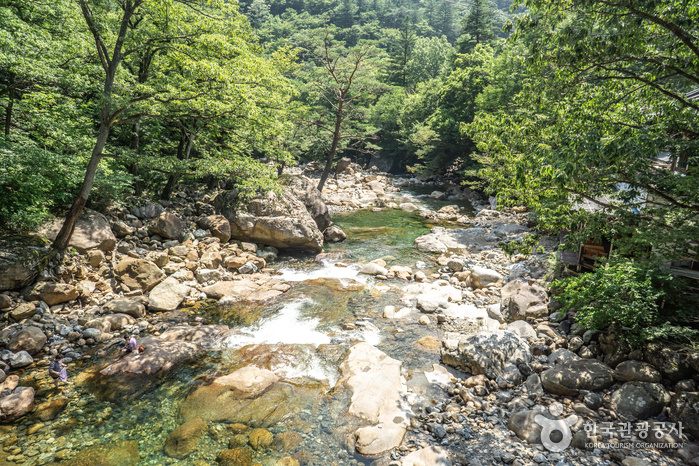
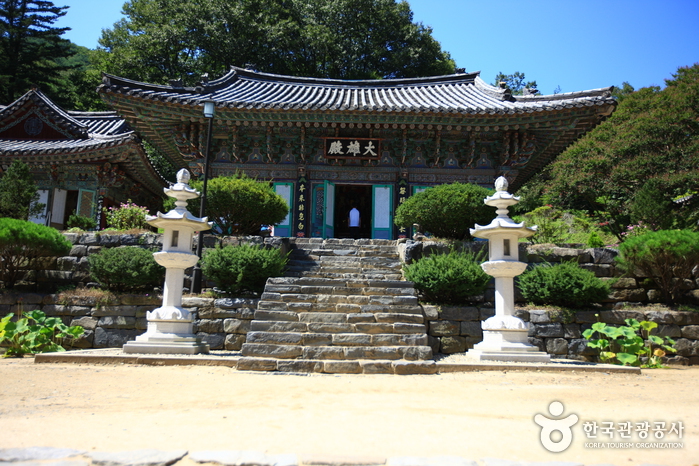

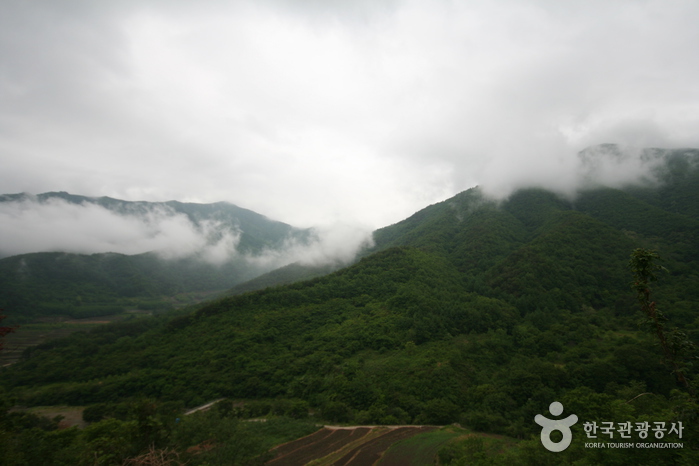
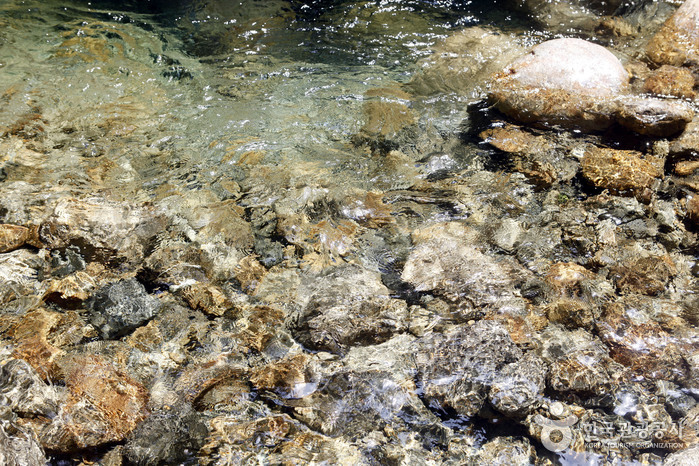
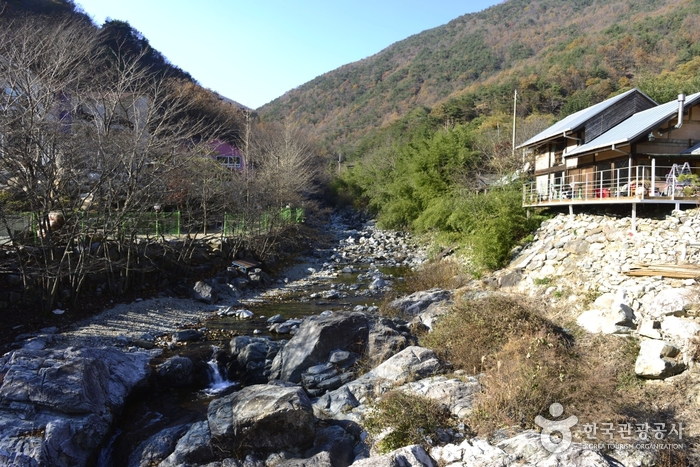
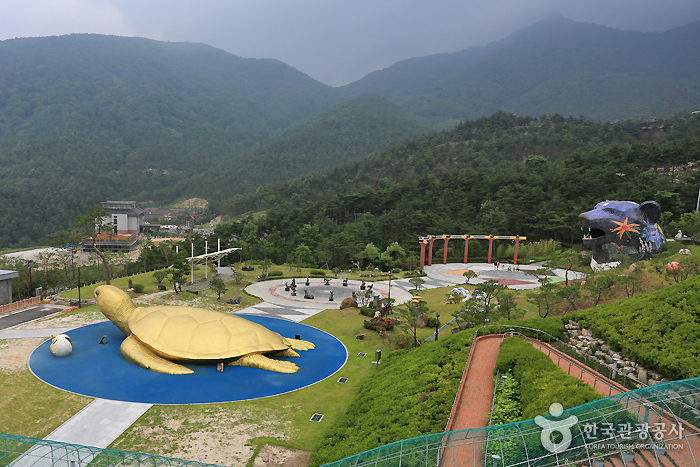
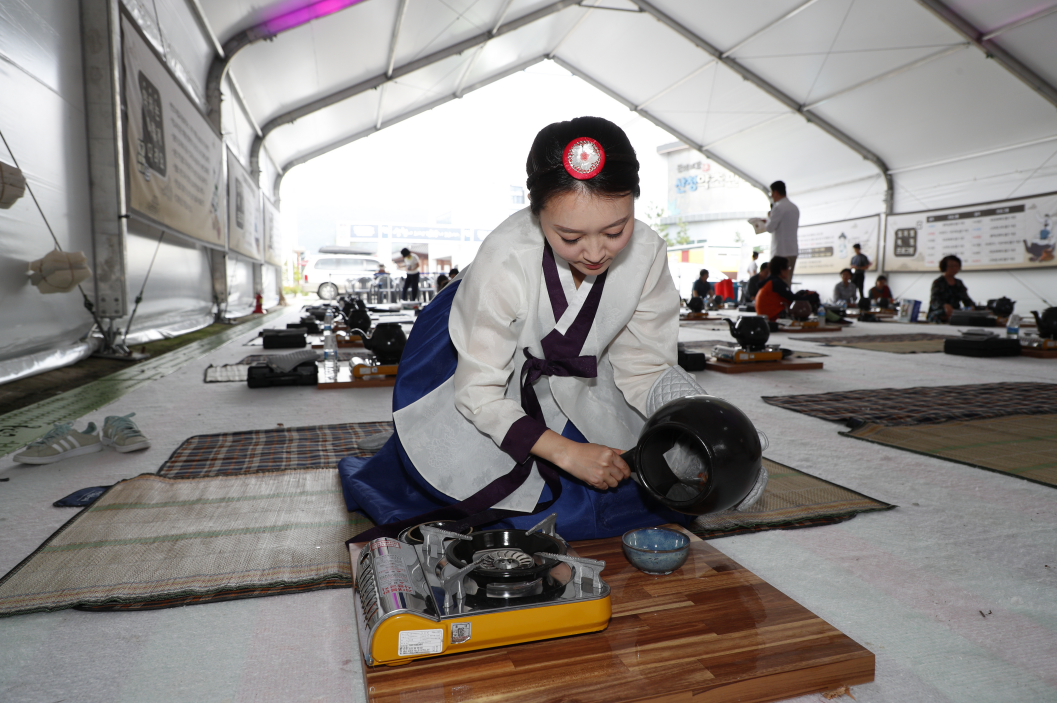
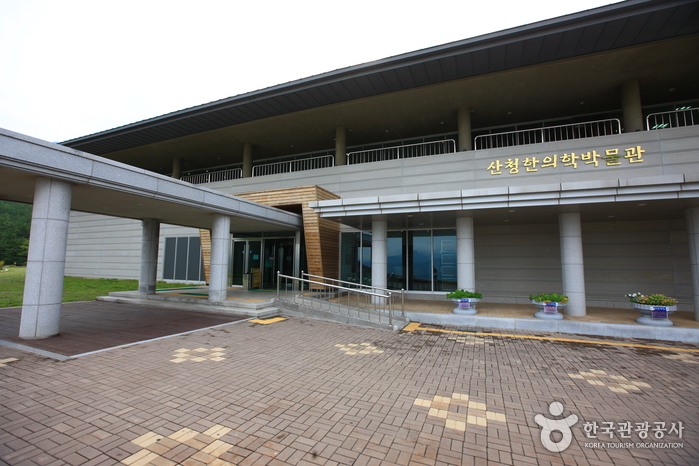
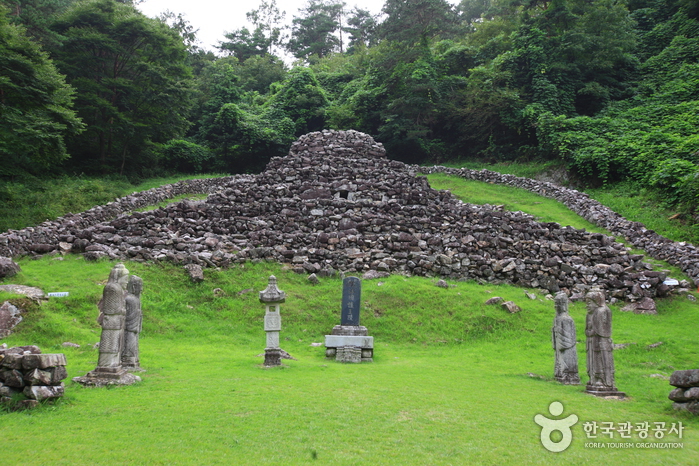
 English
English
 한국어
한국어 日本語
日本語 中文(简体)
中文(简体) Deutsch
Deutsch Français
Français Español
Español Русский
Русский